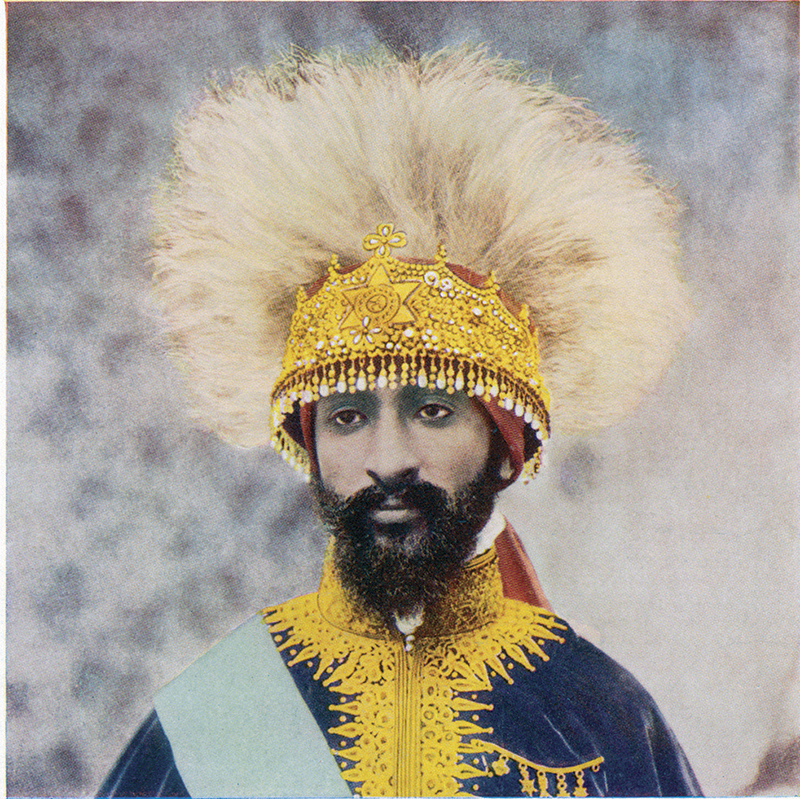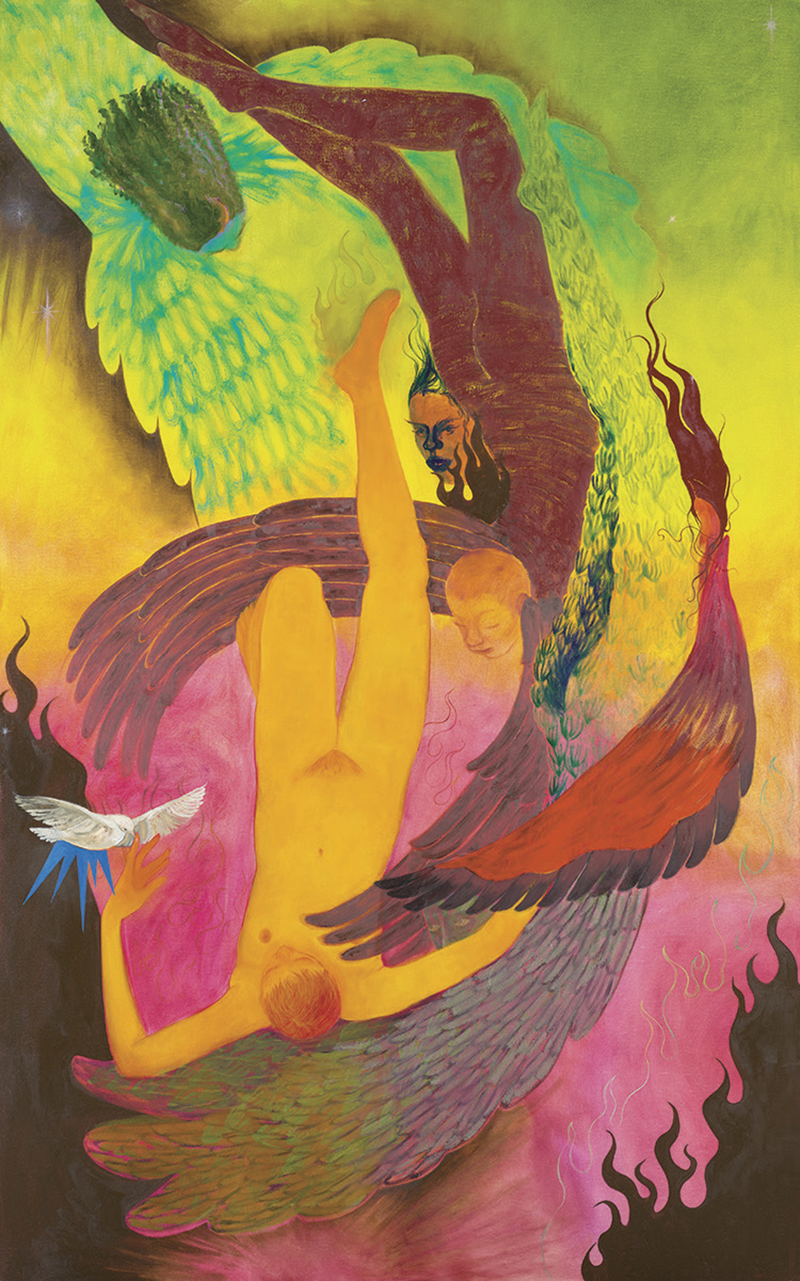
Haile Selassie I © Chronicle/Alamy
If you’ve considered accidental divinity—mortal men being worshipped as gods—you’ve probably thought it a rare phenomenon, something relegated to a distant past. But as Anna Della Subin reveals in her riveting exploration, Accidental Gods (Metropolitan Books, $35), it has occurred with startling regularity around the globe. In just the twentieth century, the unwillingly divine included Haile Selassie I (for Rastafarians), Prince Philip (for the Tanna islanders in Vanuatu), General MacArthur (for numerous groups, in places as far-flung as Panama and Japan), Jiddu Krishnamurti (for the followers of Theosophy), and Mahatma Gandhi (for many Indians, but more widely, too). Subin doesn’t write about any contemporary gods, but we might surmise that worship is still under way in unexpected quarters. Were QAnon followers to announce the divinity of Donald Trump, would anyone be surprised?
For many readers, there will inevitably be a sense of the eccentricity of such worship. In the Fifties, early Rastafarian preachers stood on street corners “preaching with the Bible in one hand and a weathered copy of National Geographic in the other.” The June 1931 issue contained an article by Addison Southard about Selassie’s coronation, which the speakers treated as near-gospel. In one Congolese cult, members entered a trance and appropriated the power of individual Belgian residents, who had the ability to “heal and protect, and avert calamities, natural disasters and theft.” Krishnamurti was “chosen” for divinity at age eleven by a pedophilic lapsed Anglican priest named Charles Webster Leadbeater (the boy was the son of Leadbeater’s secretary). Leadbeater and Annie Besant, the force behind Theosophy, groomed the reluctant child for godhood. Subin lays out the rituals of young Krishnamurti’s days, noting that Leadbeater would read Krishna ghost stories at bedtime, “in order to eliminate all fear unbefitting a deity.” Then his door would be locked from the outside.
The book is replete with such astonishing details. Subin, who combines fierce analytic intelligence with powerful storytelling, has here synthesized vast amounts of abstruse information. While another might run the risk of prurient or condescending anthropological interest in such behaviors, Subin deftly places them in the broader context of imperialism. She traces not only instances of deification, but also the social phenomena—colonization, of course, as well as the Enlightenment zeal for taxonomy—that brought them about. Many are revealed to be acts of resistance and bids for agency by oppressed peoples.
In a chapter titled “The Mystical Germ,” Subin makes the point that our very understanding of what constitutes a religion is the construct of a nineteenth-century German philologist, Friedrich Max Müller. Müller, who established the field of comparative religion, defined the term as “essentially anything that sufficiently resembled Christianity: it had a God, or several, scriptures or sacred texts, a set of tenets and rituals, and houses of worship.” Against this limiting and colonializing rubric, Subin lays out a different possibility, framed in the mortal terms of politics rather than religion:
Though the mid-nineteenth-century invention of “religion” would strive to partition the concept from “politics,” sifting out all that was mythical, ritualized, and holy in the name of secularism, modern politics can still be understood as a metamorphosis of the sacred into new forms . . . Myth is enlightenment.
The myths that deified individual British soldiers in India, or Belgian settlers in the Congo, or Captain Cook or Christopher Columbus before them, were entwined with powerfully destructive transformations. (It’s fascinating to note how often these deifications of white explorers include reverence for the tobacco and alcohol they brought with them—the colonials were drug pushers.) I was reminded, reading this book, of my childhood in Australia, where I learned that when Aboriginal children were first enrolled in white schools and ran footraces, they always lost, even though they were the fastest: their culture had raised them to leave no one behind, so they would stop and wait for their classmates to catch up. Similarly, the generous mythologies constructed by peoples in the Americas, Africa, Asia, and Australasia about arriving Europeans resulted, universally, in disaster. Subin cites the British historian Colin Kidd, who points out that religion evolved as “an epiphenomenon of race,” which many treated as scientific fact. As the scholars of empire “classified and reified sets of beliefs and rituals into distinct ‘world religions,’ ” Subin writes, those very divisions “could be seen as reflecting the racial essence of people, as the deeper truth.”
The book’s final chapter then asks the inevitable question, framed by William R. Jones in his 1973 book Is God a White Racist?: “If God is all-powerful and benevolent, then how to explain the evil of racial suffering in this world?” Jones, unable to answer, ultimately turned to secular humanism. Taking up the discussion in 2015, Stephen Finley and Biko Mandela Gray asserted that the state can itself be understood as divine and that “the state-as-god is a white racist.” The challenge Subin’s book presents—and for which it provides, in its last pages, a beautiful but idealized posthumous vision—is how to find a better array of myths.

Lest You Fall, by Naudline Pierre, whose work is on view at the Dallas Museum of Art © Naudline Pierre. Courtesy the artist and James Cohan Gallery, New York City
For such a project, we may, like those before, turn to poets and storytellers. The African-American poet Lucille Clifton was discovered by Langston Hughes in 1966, and her first collection, Good Times, received wide acclaim. Over the next fifty years, Clifton powerfully hymned, among other themes, the body and its joys, human suffering and darkness, and, centrally, family and history. (In her 1974 collection An Ordinary Woman, for instance, she writes of checking on her children at night, and envisioning her mother in the same act: “i go through my rooms like a witch watchman mad as my mother / was for rattling knobs and tapping glass.”) A beautiful selection of her poems, How to Carry Water, was published last year with a foreword by Aracelis Girmay, and this season sees a reissue of her slender but potent 1976 memoir, Generations (NYRB Classics, $14.95). The moving introduction by the poet Tracy K. Smith seems almost directly in conversation with Subin’s quest for illuminating narratives:
If light is what the work of Lucille Clifton is intent upon spreading, then I’m tempted to think that history as we have been conditioned to accept it is unrefracted, all of a piece, and blindingly white. Whereas Clifton’s imagination is prismatic; it slows down the central story so we can see what it is truly made of: all the dazzling colors moving at different frequencies and, depending upon circumstances, in distinct directions.
Smith goes on to ask, “What, then, is the vision of America that Clifton is intent upon illuminating?” She answers with the wisdom of Clifton herself: “here in America, and perhaps everywhere, no matter who we have been made to believe that we are, we are—all of us—the children of slaves.”
Generations, framed thus, is not simply an account of Clifton’s father and the generations that preceded him, narrated upon her return to upstate New York for his funeral. It is also, metonymically, the account of all our histories, of the violence on which this nation is built, and of the individuals whose lives have long been unheralded and unrecorded.
Clifton’s prose has the distilled eloquence of poetry (“Smoke was hanging over Buffalo like judgment”). She also has the gift of voices: she inhabits her father’s with an immediacy that makes him seem alive. Samuel Louis Sayles Sr. was raised by his great-grandmother Mammy Ca’line:
She was born among the Dahomey people in 1822, Lue. Among the Dahomey people, and she used to always say, “Get what you want, you from Dahomey women.” And she used to tell us about how they had a whole army of nothing but women back there and how they was the best soldiers in the world.
The music of her father’s words is both conversational and poetic, and Clifton’s particular achievement is to render the two as one, life as lyric, without prettifying or sentimentalizing.
The familial outline of her father’s life is one of unspeakable rupture and violence, and yet it’s also a narrative of intense love and care across generations. Samuel, born in 1902, was the son of Gene Sayles, who died when Samuel was a child. He was then raised by his great-grandmother, after his grandmother was hanged for the murder of Gene’s father, a white man named Harvey Nichols. Though he laments Gene’s failings, elsewhere Samuel sees his father’s travails more clearly. When Lucille and her siblings would say that they had a crazy grandfather, her father would sigh: “No he wasn’t crazy. He was just somebody whose Mama and Daddy was dead.”
In Clifton’s own immediate family, lines were complicated yet nurtured by mutual care. She was one of three daughters by three different women, but, she writes, “Our mothers had all known each other, had been friends.” This complexity—this colorful prism—is what abides from a family history of sufferings, hardships, and losses. “Things don’t fall apart,” Clifton writes. “Things hold. Lines connect in thin ways that last and last and lives become generations made out of pictures and words just kept.”

Cave and Water, by Claire Sherman © The artist. Courtesy Patron Gallery, Chicago
Of course, stories can also serve as the antithesis of myth. Certainly this is the case with the Swiss writer Peter Stamm’s new collection It’s Getting Dark (Other Press, $22.99), which takes familiar outlines or premises and deflates or distorts them. Stamm, whose precise, dry prose builds suspense in its very insistence on the quotidian, creates narratives simultaneously ordinary and strange, even uncanny. Atmospherically, these stories recall Arthur Schnitzler, or even Edgar Allan Poe: eventfulness is promised, then elided; death or oblivion hovers at the edges of an ordinary afternoon.
In the haunting title story, a police officer, recently relocated to the mountain village where she spent her childhood, sets out to search for a woman and two children who’ve apparently gone missing from a highland hut. But the trio is perhaps only imaginary: “No one had actually clapped eyes on her, they had only heard it said by X or Y that they had been seen in the distance.”
It transpires that many years before, the narrator, along with her mother and brother, once lived in the very hut she comes to investigate, and that when she was ten, her brother vanished there. Though he was searched for, “nothing that gets lost in the karst is ever found.” (A karst is a landscape of caves and sinkholes formed by the dissolution of rock.)
The narrator, having renounced her own search as the day draws to a close, then encounters “the woman,” who has a storybook air, “wearing old-fashioned clothing” and “carrying a stick.” The narrator assumes this is the mother of the missing children, as do we, but the woman speaks gnomically, acknowledges nothing. Perhaps the children never existed; perhaps, indeed, the children are the narrator and her brother, a story from years before; perhaps the narrator and the woman are one. A story that opens in grounded certainties, in Flaubertian details that insist on the real—“ladles and pots hanging on nails in the walls, a small hatchet, an almost blind mirror”—ends in uncertainty and abstraction, with the narrator lost in a haze of diffuse light: “I can be a little girl, a young woman, an old woman, up here it doesn’t make any odds. . . . It’s my cry that is swallowed in the fog, my joy or lament, my ecstasy.”
A similar bafflement falls on many of Stamm’s characters, interrupted in the banal run of their days. In “First Snow,” a distracted husband is abandoned by his wife and kids at a rest stop, and, after walking into the snowy landscape, has a dreamlike encounter with a teacher in a school on a hill. In “Marcia from Vermont,” a man at an artists’ residency in Vermont recalls his complex love affair years before with a woman, Marcia, whose family ran the foundation that hosts the residencies, and whom he hopes to find there. What he discovers instead seems momentous, and yet he absorbs it with muffled equanimity, as if in a dream, like the banquet he attends alone in a blizzard.
In “Cold Reading,” a woman on a cruise who disembarks for the day in Barcelona finds herself on the doorstep of a clairvoyant named Kumar. Rather than telling her future, he tells her the truth: “I tell them what they want the future to be. And for that they’re grateful, whether it happens or not.”
Repeatedly, in Stamm’s ghost-filled collection—beautifully translated, as are all his books, by the remarkable Michael Hofmann—the story proves to be an antistory, but no less a story for that: “I can see how everything will end,” Kumar goes on to explain, “But then it always ends that way anyway. What I can’t see is what we make of it, what we’ll look back on. And that’s what happiness is.”






































































































